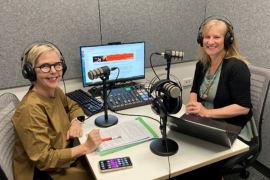The role of early assessment and feedback
The strategic use of formative or low-stakes assessment during the initial weeks of a unit of study provides important feedback for both students and for educators:
- Students: it is important to provide students with early feedback to give them an indication of academic performance and suitability for the course (Nicol & Macfarlane‐Dick, 2006). Early assessment helps students understand their strengths, areas for improvement, and strategies for academic success. Timely and constructive feedback early on in a unit can enhance students’ learning experience, fuel their motivation, and improve their self-regulation skills (Hattie & Timperley, 2007).
- Educators and those supporting students: early assessment enables students who may need advice on enrolment choices or may be at risk of underperformance or disengagement to be identified early enough for timely intervention to be possible (Crisp, 2012).
There is considerable evidence for the positive impact of early assessment and feedback on academic performance and engagement:
- Students who receive early feedback can gauge their understanding, adjust their study strategies, and approach their coursework proactively (Tinto, 2012).
- Early feedback increases student engagement and belonging by providing a clear link between effort and performance (Yorke, 2001; Tinto, 2012).
- Early assessment enables educators to intervene promptly and provide additional support when necessary (Crisp, 2012).
- Early assessment and feedback have been found to improve students’ subsequent performance with Vaughan et al. (2014) reporting that students use it to rectify their misconceptions and improve their performance in subsequent assessments.
When in a unit should early assessment be used?
Diagnostic assessment is used at the start of a unit or even before teaching starts to provide information about what students know from previous study. Mid-semester assessment is commonly used as a more substantial summative measure of the unit learning outcomes. Early assessment is different to both, and provides feedback on students’ understanding of the introductory content in the unit. Census date provides a pragmatic marker: early assessment should be timed such that feedback can be provided, communicated and acted on before the census date for the unit.
Institutions are required under legislation to set a census date for every unit of study. It is the date a student’s enrolment is finalised. After the census date, a student can generally not withdraw without incurring financial or academic penalty. The census date for a unit running in a semester or in an intensive session must be set when at least 20% of the teaching has occurred. The census dates for Sydney are set by the Academic Board and are available on the public-facing website and generally occur when between 1/4 and 1/3 of the teaching has been completed to enable students to have experienced a substantial portion of the unit before finalising their financial and academic commitment.
Particular importance for commencing and equity students
As part of Kift’s six first-year curriculum principles, early assessment and feedback should be embedded in the curriculum design to enable a successful transition to university. For commencing students, early assessment is important for fostering student engagement, enhancing student learning, and ultimately, improving student retention and success. In addition, Nicol’s framework for first-year assessment practices (2009), revised by Thomas (2018), highlight the role of early assessment and positive feedback on self-esteem and self-efficacy (Weeks and Bridgeman, 2021). As highlighted in Lizzio’s “Five Senses of Student Success” model (Chester et al., 2013; Lizzio, 2006), students’ understanding of their capability and the expectations and standards placed upon them are crucial to retention and success. For students from underrepresented groups, including first-in-family students, knowledge of these expectations can be part of the ‘hidden curriculum’ of ‘unspoken rules’ (Cotton et al., 2013).
Examples from across the disciplines
With these assessments we ideally would like to find all students who are at risk of failing the unit, but these students can be broadly grouped into two categories. The first group is non-participating enrolments (NPEs) or ‘ghost students’, those who do not make a good-faith effort at completing or even starting a unit of study, and to whom we would subsequently give an Absent Fail grade. Being an NPE is correlated with low success and retention, particularly for select groups of equity students (Stephenson et al., 2021). NPEs can be more straightforward to spot, as they may have spent very little or no time on Canvas or attended any classes, and so these students will generally be easy to identify with any of the tasks listed below. The second group who can be harder to spot are those who do make a good-faith attempt at the unit, submitting the majority of assignments, but still receive a failing grade. We often see these marginal students re-enrol over and over without reaching out for help, so think as much as possible about how you can target this second group when designing your pre-census assessment.
The suggestions below can either be implemented in Canvas or in/during existing classes, and can either be automatically marked or require zero or minimal additional non-contemporaneous marking time.
Weekly quizzes: Many units already integrate these, in the form of content review, pre-lecture, or checkpoint quizzes. Quizzes can be an excellent way of measuring understanding of pre-class materials such as videos, readings and laboratory instructions and work with most disciplines. They are popular with students as they provide instant feedback, helping to build self-efficacy motivate attendance and engagement.
Concept quizzes: Similar in delivery style to “Weekly quizzes”, concept quizzes (or “ConcepTests“) generally use multiple choice questions written to probe understanding of ideas and concepts rather than to test comprehension. Banks of well designed questions are available for many disciplines on the internet, from the physical sciences to postmodernism.
Text analysis writing task: In class, students answer questions about a short piece of text and group their answers under appropriate headings such aa “Purpose”, “Authors”, “Audience” and “Topic and Position” with marking completed in the class. These are often used in the first few weeks of semester to give students repeated practice with basically the same task.
Peer review writing activity: Students complete an analysis task of a piece of writing in class and then exchange these with a neighbour. After each student evaluates the new paper, they then compare notes and record their reviews via a rubric in Canvas.
Minute papers: At the end of each tutorial or lecture, students take one minute to write down what they have learned and/or any questions that they have after the session. Also helpful for teachers to identify areas worth revisiting in the next class, these can be submitted through Canvas or the Student Relationship Engagement System (SRES).
Critical reading task: This activity takes students through the process involved in reading a text. Starting with their larger assignment task, students follow steps that help them read efficiently and think critically. A note making template is provided to students and its completion is assessed.
Project outline or work-in-progress (WIP): Units with large assignment-type assessments (categorised as an essay, report, case study, proposal, literature review, portfolio, or design) are the product of weeks-long skills and knowledge mastery. By census date, approximately a third of the way into semester, how much of this work could students reasonably be expected to do? An outline of the students’ plan for this task, or a presentation of their work-in-progress, will help you gauge how they are progressing and provide meaningful feedback to get them back on track.
Group charter: Units with group assessments could consider implementing an un- or low-weighted group charter or contract. These support students in co-creating a working environment with their peers and can be used to think through upcoming task requirements. To check individual student engagement we recommend asking groups to clearly indicate the members who contributed to its development.
Unit outline quiz: If you get a lot of questions that can easily be answered through a good look at the unit outline or information posted on Canvas, consider creating a Canvas quiz covering the relevant information. If this quiz is placed inside a module and set as a requirement for proceeding to subsequent modules, non-completion of the quiz will be a strong indicator of a very disengaged student. A low score may indicate a struggling student. Make sure to add feedback to the quiz to ensure equitable access to information and reach out to students who are having trouble with it.
Library task: Familiarity with the Library, whether virtual or physical, is important for all students. Integrating it into your pre-census assessment will help students build confidence in accessing this vital resource. Students could be asked to find a particular article and submit it to a Canvas assignment or discussion board, or they could go on a physical or virtual site visit and complete a Canvas quiz afterwards.
Safety induction: Almost all small classes scheduled in laboratory spaces will already integrate a safety induction of some sort into their first few weeks. Tracking student completion of these, as well as teacher notes about any non-compliance in class, could be used to identify under-engaged students.
Engagement with digital tools: Coordinators of units of study that use Canvas plugins like EdStem, LabArchives or PebblePad could utilise those tools’ analytics to track student engagement. It is quite easy to upload this information to a Canvas assignment to enable centralised tracking and offering support for students who are disengaged in multiple units.
Tell me more!
This article has focused on why and how to include early assessment and feedback. The information such tasks provides educators with can also be used to support students through personalised communications. Full details of the process for 1000-level coordinators is available in the article:
Come along to an information and support session:
Register for a workshop on early feedback tasks in 2024
For more information on how to do this at scale, read:
- Alix Thoeming’s guide to ‘Supporting students through HELP funding changes‘
- Danny Liu’s article on ‘Personalising learning support in large units using SRES’
- Ruth Week’s and Becky Denham’s article on ‘Marking and feedback of early feedback tasks‘
- You can also book a consultation with the Educational Innovation team for a half-hour brainstorming session about how you might integrate one of these tasks in your unit.
References
- Chester, A., Burton, L. J., Xenos, S., & Elgar, K. (2013). Peer mentoring: Supporting successful transition for first year undergraduate psychology students. Australian Journal of Psychology, 65(1), 30-37. doi.org/10.1111/ajpy.12006
- Cotton, D., Winter, J., & Bailey, I. (2013). Researching the hidden curriculum: intentional and unintended messages. Journal of geography in higher education, 37(2), 192-203. doi.org/10.1080/03098265.2012.733684
- Crisp, G. T. (2012). Integrative assessment: Reframing assessment practice for current and future learning. Assessment & Evaluation in Higher Education, 37(1), 33-43. doi.org/10.1080/02602938.2010.494234
- Hattie, J., & Timperley, H. (2007). The power of feedback. Review of Educational Research, 77(1), 81-112. doi.org/10.3102/003465430298487
- Kift, S. (2009). Articulating a transition pedagogy to scaffold and to enhance the first year student learning experience in Australian higher education: Final report for ALTC Senior Fellowship Program. Strawberry Hills, NSW: Australian Learning andTeaching Council.
- Nicol, D. J., & Macfarlane‐Dick, D. (2006). Formative assessment and self‐regulated learning: A model and seven principles of good feedback practice. Studies in Higher Education, 31(2), 199-218. doi:10.1080/03075070600572090
- Stephenson, B., Cakitaki, B., & Luckman, M. (2021). “Ghost student” failure among equity cohorts: Towards understanding non-participating enrolments. National Centre for Student Equity in Higher Education [Accessed 31 October 2023] Available at: https://www.ncsehe.edu.au/publications/ghost-student-failure-equity-cohorts-non-participating-enrolments/
- Tinto, V. (2012). Leaving college: Rethinking the causes and cures of student attrition. University of Chicago Press.
- Thomas, T. (2018). Implementing first-year assessment principles: An analysis of selected scholarly literature. Student Success, 9(2), 25-38. doi.org/10.5204/ssj.v9i2.410
- Yorke, M. (2001). Formative assessment and its relevance to retention. Higher Education Research & Development, 20(2), 115-126. doi.org/10.1080/758483462
- Vaughan, S., Sanders, T., Crossley, N., O’Neill, P., & Wass, V. (2015). Bridging the gap: the roles of social capital and ethnicity in medical student achievement. Medical Education, 49(1), 114-123. doi.org/10.1111/medu.12597





